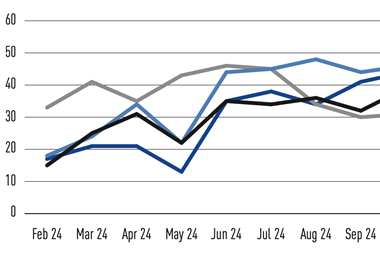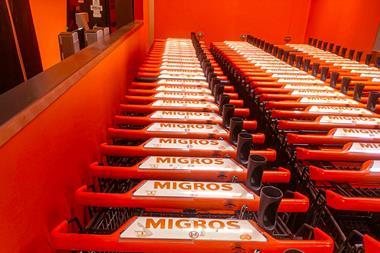The rise of the internet brought with it a new model for doing business electronically. In many ways, financial instruments are the ideal products since they are largely non-material and their trading essentially involves the communication of information. Because this information can now be moved electronically, trading platforms offer some substantial potential benefits in terms of greater efficiency in the trading process and reduced costs. However, reaping the benefits is not entirely straightforward and requires investment in the technological links to trading venues and in the systems to automate the processing of trades.
Electronic trading in domestic equity markets is well established in Europe. What the internet has brought is the potential to trade efficiently across borders, either through the consolidation of two or more national exchanges on to a single platform, or the creation of a single pan-European trading platform, or through the use of systems that can access multiple markets from a single screen.
Euronext is the most successful consolidation, bringing together cash and derivatives exchanges in Amsterdam, Brussels, Paris and Lisbon and the London International Financial Futures and Options Exchange (Liffe). Not only does this give a single point of access to the listed stocks of these countries, but it also offers greater efficiency of trading through its consolidated clearing system called Clearing 21.
There have been a number of attempts to create pan-European equity markets in recent years, most of which have failed. Their proponents tend to claim that their demise was because the timing was unfortunate, coinciding as it did with the bursting of the dot-com bubble, while critics suggest that the demand for cross-border trading venues was always exaggerated. The closure of Nasdaq Europe in June left only Virt-x remaining of the dedicated cross-border platforms. Now owned by the Swiss Exchange and backed by a number of major banks such as UBS and Credit Suisse First Boston, Virt-x predominantly trades Swiss blue-chip stocks. However, it does offer integrated trading and settlement and enables so-called straight-through processing (STP) of trades, whereby deal information is passed straight through into the clearing and settlement systems allowing the process to be automated, improving efficiency while reducing the errors that result from manual processing, reducing costs.
To take full advantage of these improved efficiencies and cost reductions, buy-side firms need to connect electronically either directly with the exchanges or to their brokers. A standard interface called Financial Information Exchange (Fix) has been developed for this purpose and is now widely adopted. An order can be keyed in by the buy side organisation and sent over the Fix interface to the broker, with electronic execution at the exchange and clearing and settlement information communicated directly back to the organisation’s systems.
A number of banks and brokers, such as Merrill Lynch, Morgan Stanley and State Street, have set up platforms that offer things like market research, portfolio analytics, trade execution, order management, risk management and confirmation matching services, all aimed at reducing the investment that buy-side organisations have to make in their technology infrastructure.
Trading systems suppliers also offer electronic access to multiple exchanges, while acting as agency brokers and competing with traditional brokers. Some industry observers say that because these companies, such as Stockholm-based NeoNet, Paris-based Global Trading Systems (GTS), Frankfurt-based Realtime Systems and London-based Ffastfill, allow firms to trade across European exchanges from a single terminal they have effectively eliminated the need for a specialist pan-European stock exchange.
Also established to take advantage of new trading technologies were the crossing networks, most notably Posit and E-Crossnet. Both offer electronic or phone-based trading, where bids and offers are brought together at a series of timed matchings during the day. Posit and E-Crossnet both claim not only to offer the cost-efficiencies of electronic trading but – because they are anonymous and confidential – they allow large trades to be made with no market impact, often cited to be the biggest cost risk of doing large deals.
In foreign exchange trading markets, the internet has prompted leading players to create their own portals where buy-side organisations could trade electronically with the banks. Depending on its level of technology, a buy-side organisation could establish a link to the portal and achieve straight-through processing of trades. While this brought many benefits, it locked the organisation into the bank’s prices. What many buy-side organisations sought was greater price transparency, and in response a number of multi-bank portals were established. Some have come and gone, while the successful ones – primarily State Street’s FX Connect, independently owned Currenex and bank consortium-owned FXall – continue to gather liquidity.
State Street initially launched FX Connect as a proprietary portal – part of its Global Link electronic trading platform that includes the equity order entry and routing application Equity Connect. However, the bank saw increased buy-side demand for price transparency and in early 2000 opened FX Connect up to other banks. Now 37 banks, including ABN Amro, Barclays Capital, Deutsche Bank and JP Morgan, participate in FX Connect giving it by far the largest share of multi-bank portal FX trading, reaching volumes of $20bn (e17bn) a day in May.
While multibank portals can offer substantial benefits to buy- side organisations in terms of providing a single venue where they can see the prices of many banks and in offering a single point of connection to those banks for trading purposes, there are drawbacks for both sides. A buy-side organisation may prefer to trade with the bank with which it has traditionally had a relationship but which does not operate a portal of its own or participate in a multibank site. And there is a fierce struggle going on among the top 10–20 FX players for market share at present, requiring enormous investment in technology. As a solution, a number of these top banks are now offering their FX services on a ‘white label’ basis to smaller banks that can’t afford the investment in technology to compete directly in the market themselves but still want to offer FX services. ABN Amro, for example, offers mid-tier banks a full front-to-back office FX operation which they can label as their own. Pioneered in the US, the service is now being introduced in Europe and elsewhere. The advantage to buy-side firms is that they can continue to do business with their local bank while getting the prices and technological benefits in terms of the efficiency of STP of dealing with a major FX bank. Meanwhile, the local bank gets to keep buy-side organisations’ business and the major bank gets the liquidity.
The internet has already transformed equity and FX trading. But the technology and business models are still evolving. Buy-side organisations need to evaluate carefully where to invest their resources to take greatest advantage of the new electronic markets.












No comments yet